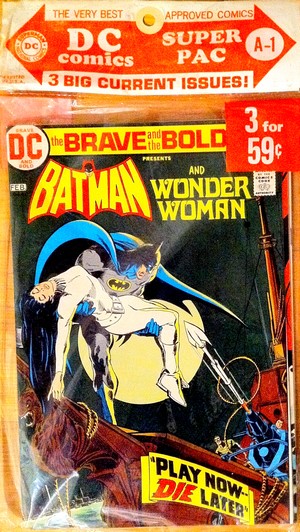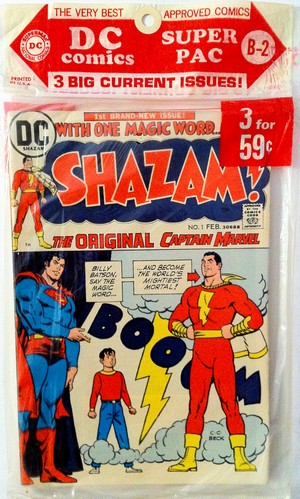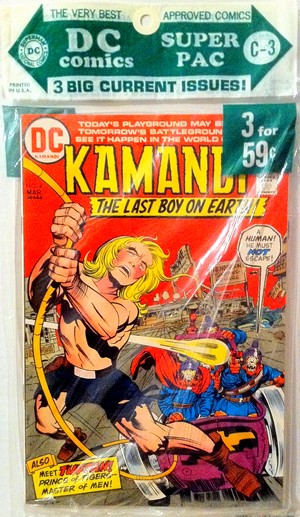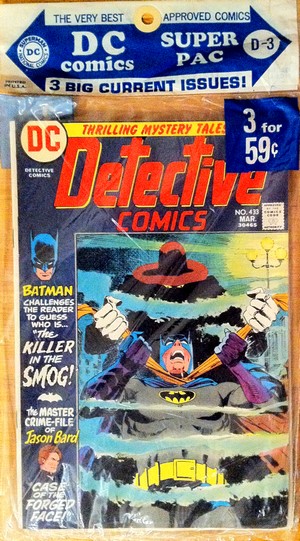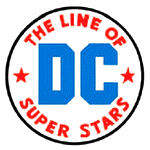 |
| |
 |
|
DC
SUPER
PACS
THE
YEAR 1973
|
|
|
| |
| |
|
| 1962 was a
year of crisis for the US comic book industry. For the
first time in the perceived history of comic books the
publishers were forced to raise their cover prices, as
rising production costs and inflation cut too deeply into
profit margins. The subsequent increase from 10¢ to 12¢
triggered a brutal drop in sales across the board, with
DC Comics alone being rumoured to have lost more than
$600,000 in comparison to the previous year (Wells,
2012); the statements of ownership required by the US
postal services show that the sales figures for DC
flagship titles such as Superman, Action
Comics and World's Finest dropped by around
25% in 1962 as compared to 1961. DC Comics (which
still called itself National Comics at the time) tried to
offset these losses by opening up new sales opportunities
and markets and tap into a new customer base, and the
means to do so was to start selling comic books in
packaged bundles as opposed to the classic individual
newsstand copy.
|
| |
| Starting
with the August 1962 cover date
production run, DC called
it the COMICPAC. "Comicpacs
are 4 brand new DC Comics in a plastic
bag", in-house ads explained,
emphasizing that they could be purchased "at
supermarkets and other retailers".
Supermarkets - in stark contrast to the
comic book's historical sales venues -
were booming. They were popular because
they sold many different things under one
roof - and evidently, comics were not
amongst the merchandise they carried. But
by looking at the logistics and display
strategies of these outlets, DC found
that the answer to breaking into this
promising new market was simple -
packaged in plastic bags, DC's comic
books literally blended in with a large
proportion of other goods sold at
supermarkets and chain stores. |
|
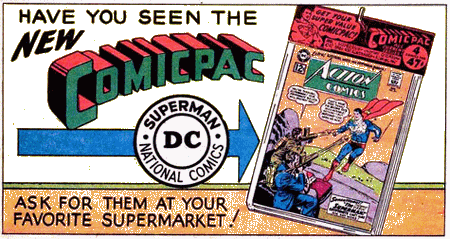
In-house
ad from Blackhawk #175 (August 1962) for
DC's "new" COMICPAC,
featuring a bag containing Action Comics
#291 (August 1962)
|
|
|
| |
| Strategically placed close
to checkouts and cash points, DC's comic packs were a
success. Following a hiatus between late 1969 and
mid-1971, the Comicpac was relaunched and rebranded as
"DC Super Pac". |
| |
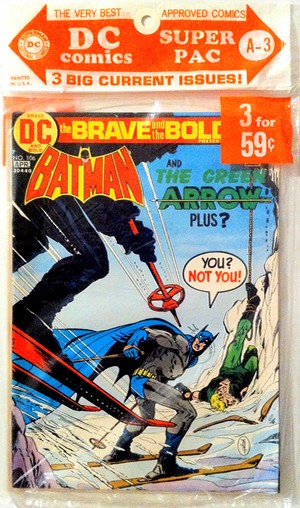
Super
Pac A-3 from 1973, with Brave and
the Bold #106 as one of its
showcased titles
|
|
All of DC's
comic packs were
reference-numbered right from the
start in 1962. This was carried
over into the 1970s after the
relaunch and translated into a
code using a letter plus digit -
for example, the Super Pac
pictured here is the
"A-3" pack from 1973,
i.e. the first SuperPac
("A") produced for
March ("3").
Rather than
just filling the plastic bags at
random with any three comic
books, a specific Super Pac would
thus carry the same three titles
no matter where or when it was
sold (a few rare exceptions to
this rule exist, which are
probably either due to packaging
errors or makeshift fixes to
running out of copies of a
certain title).
This raises
the question of the decision
making ivolved in determining
which comics went into which
Comicpac. Little to no
information on this seems to be
publicly available, but the
complete data from 1973 shows a
clear tendency to include DC's
popular or iconic characters and
their books. The SuperPac was
not, therefore, a convenient
means to dispose of surplus stock
or unpopular titles - on the
(obvious) contrary: DC wanted the
Super Pacs to sell.
It is hard to
tell if the casual buyers even
paid any attention to DC's neat
code system, but it is an
indication of how organized and
structured the comic packs
business at DC was. Marvel, in
comparison, dropped codes all
together in the 1970s, and as a
result there is no systematic
indication of how many different
"Multi-Mags" the House
of Ideas was releasing during the
1970s.
| |
|
|

|
|
you
can read more about the
history and background of
DC's COMICPAC here.
|
|
|
|
|
| |
| |
1973 - THE DC SUPER PAC YEAR
IN NUMBERS
DC sold four
Super Pacs each month of the year, resulting in an
overall total of 48 comicpacks for 1973; as every Super
Pac contained three comic books, the total number of
different issues packaged throughout 1973 is 144, which
is a good third (36% to be precise) of the total 401
issues DC published with a 1973 cover date.
The 1973 run
of Super Pacs offered buyers a total of 37 different
titles, ranging from the year's full run of 12 issues
(e.g. Superman) to a mere single issue (e.g. House
of Mystery).
The following graph lists
all titles featured in the 48 Super Pacs from 1973 in
order of the number of issues carried. A total of 5
titles had all of their issues published in 1973 featured
in Super Pacs (indicated by a green bar in the graph): Superman
(12 issues), Batman (7), Brave and the Bold
(6), Champion Sports (2) and Shadow
(2).
|
| |
| Of
these, the two Batman titles were ongoing
but not monthly publications, while both Champion
Sports and Shadow had only
started their publication run in
September 1973. 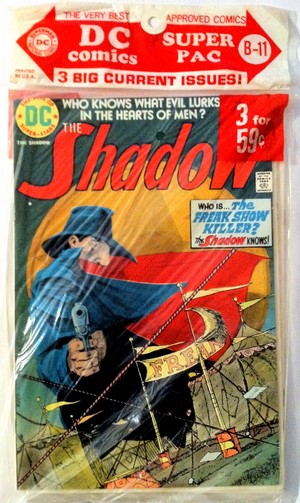
Super Pac
B-11 features issue #2 of The Shadow, a
new bi-monthly title which had both of
its issues published that year included
in the 1973 run of Super Pacs
|
|
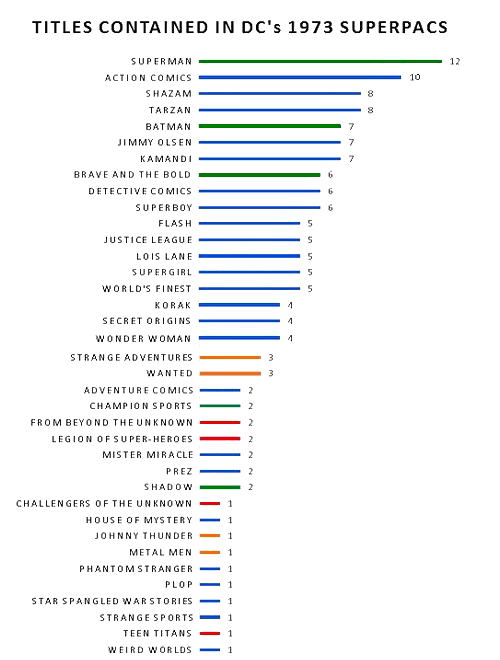
|
|
|
| |
| Other titles were limited
in being included in Super Pacs by the fact that they
were cancelled in 1973 (orange bar); in some cases, the
final issue of that title was even included in a Super
Pac (red bar). The
distribution of all the 37 different titles (in
alphabetical order) across the 1973 Super Pacs production
is shown in Appendix I (scroll to bottom of page) while
the actual contents of the 48 1973 Super Pacs can be seen
in Appendix II.
|
| |
| |
THE 1973 DC SUPER PACS IN
PERSPECTIVE
|
| |
| Ever since the initial
success of Superman in 1938 there has been a symbiotic
relationship between DC Comics and its superhero
characters. DC created and perfected the genre, which in
return always gave the company a relative stability -
even when superheroes went out of fashion in the late
1940s and first half of the 1950s, DC's Superman, Batman
and Wonder Woman remained popular. Unlike other comic
book publishers, DC never had to totally reinvent itself. |
| |
| The
defining role of the superhero genre
(DC's logo would prominently feature the
wording SUPERMAN in one form or
another from 1942 right up to 1970) is of
course also reflected in the contents of
the 1973 run of Super Pacs: 21 out of the
37 titles packaged into those plastic
bags throughout the year were superhero
titles, equaling 57%. By the end of 1973,
DC Comics offered subscriptions to 48 titles (the total
number published was slightly higher but
titles which sold poorly, weren't
expected to last or already slated for
cancellation were not made available for
subscription (including e.g. Champion
Sports, which was however carried in
two different Super Pacs).
Comparing
these 48 titles on the subscription list
to those included in the Super Pacs
throughout 1973 shows a few distinct
differences. Most strikingly, superhero
genre titles made up for only 38% of the
subscription titles as compared to the
57% share they had in the Super Pacs -
which carried all superhero titles
available for subscription with a couple
of issues at least, plus three titles
which either went on hiatus or were
cancelled outright in 1973. Superheroes
sold well at the general public
salespoints of supermarkets and retail
stores, no doubt also thanks to immediate
recognition and thanks to their iconic
stature.
|
|
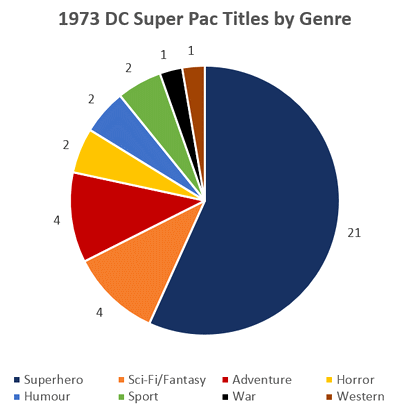
|
|
|
| |
| The massive
over-representation of the superhero genre happened
mostly at the statistical expense of DC's substantial
selection of horror titles, a popular line of solid
sellers throughout the 1970s. |
| |
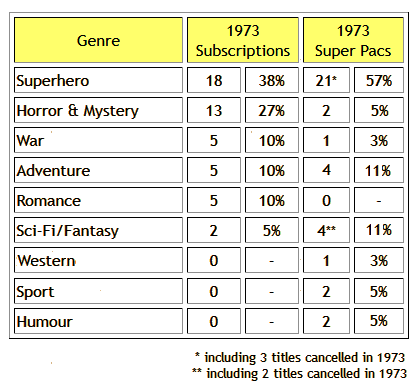 |
|
Another
constant in DC's portfolio of titles with a loyal
readership was the war genre, which also found
its way into the 1973 Super Pacs in all but a
very marginal way, although still faring better
than DC's line of romance titles - which didn't
make it into the 1973 Super Pacs at all. On the other end of the
spectrum, Sci-Fi and Fantasy titles were also
over-represented in the Super Pacs, although here
(as with the superhero titles) the difference is
partly also due to the fact that the Super Pacs
featured a couple of titles which ultimately were
cancelled in 1973 (and therefore were not
featured on the subscriptions list).
The only genre to be
represented in almost equivalent percentages were
the so-called adventure titles (such as Tarzan
or Kamandi), while no less than five
titles could be found in various Super Pacs which
represented three genres not open at all to
subscriptions in 1973: Sport, Humour and Western.
|
|
| |
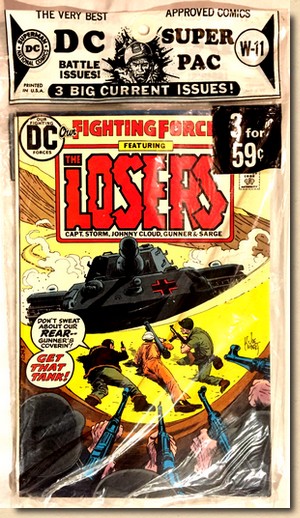
|
|
However, both the
horror and the war genre got at least one
extra Super Pac appearance in late 1973 -
in specially themed packs*. Labelled
"Mystery Pack", DC's special
Super Pac M-10 featured House of
Mystery #219, Swamp Thing
#7 and Witching Hour #36.
A second
specially themed Super Pac was labelled
"Battle Issues", coded W-11,
and featured Star
Spangled War Stories #176, Weird
War Tales #20 and Our Fighting
Forces #146.
Themed comicpacks
would seem to be a good idea from a
selling argument's perspective, but
overall they were the exception until
Whitman would produce character themed
comicpacks in the late 1970s. DC did,
however, produce a second war pack (W-1)
for January 1974, but other than that
there is no evidence to date which would
confirm any more themed Super Pacs.
* These special Super
Pacs as well as the comic books featured
in them have not been included in the
regular 1973 Super Pac statistical data.
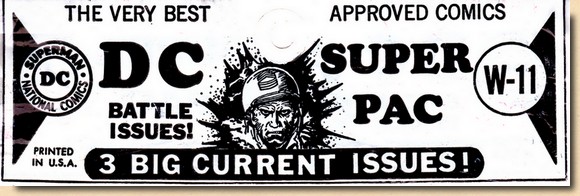
|
|
|
| |
| The fact that the 1973
Super Pacs also featured no less than 8 titles which were
cancelled at some point throughout the year may at first
sight seem like an exceptionally high quota (it being,
after all, more than one fifth of all titles contained in
that year's Super Pacs). |
| |
However, the early 1970s were
an era of experimentation both at DC and Marvel.
New genres and new takes on established
characters were being explored and tested all the
time, and while some things worked out, others
didn't.
"The
ones that didn't sell didn't last very long,
obviously. We did flood the market, but
remember, this was that period (...) where
Marvel suddenly decided to put out a whole
bunch of books, and DC would have to match it
(...) it was just constantly playing around
with stuff, trying to get market share... it
was really survival of the fittest. There
were only these two companies, really, doing
that kind of comic, competing with each other
(...) lots of stuff came out in the '70s
because of this approach."
(Roy Thomas, in Cooke 2001)
In
1973 alone, DC Comics published fifteen new
titles while cancelling fourteen. The balance in
the Super Pacs was somewhat tilted towards the
latter, but not excessively so.
|
|
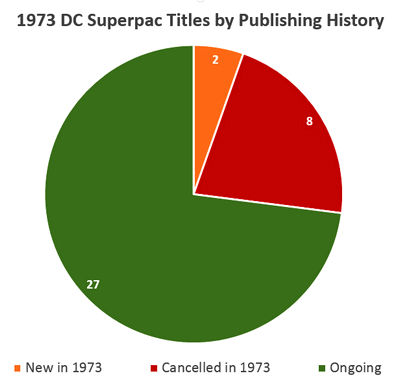
|
|
| |
| DC's 1973 SuperPacs offered
buyers complete runs of three titles: Superman, Batman
and the Batman team-up title Brave and the Bold. |
| |
| 1973 |
JAN |
FEB |
MAR |
APR |
MAY |
JUN |
JUL |
AUG |
SEP |
OCT |
NOV |
DEC |
| Superman |
B-1
#260 |
B-2
#261 |
B-3
#262 |
A-4
#263 |
A-5
#264 |
A-6
#265 |
A-7
#266 |
A-8
#267 |
A-9
#268 |
A-10
#269 |
A-11
#270 |
A-12
#271 |
| Batman |
|
B-2
#247 |
|
B-4
#248 |
B-5
#249 |
C-6
#250 |
|
C-8
#251 |
C-9
#252 |
C-10
#253 |
|
|
| Brave
and the Bold |
A-1
#105 |
|
A-3
#106 |
|
A-5
#107 |
|
B-7
#108 |
|
A-9
#109 |
|
A-11
#110 |
|
|
| |
| In 1973, Superman was by
far DC's flagship character, and his namesake title
easily topped DC's list of publications. Although caught
in a steady decline since the late 1960s (as was the case
with pretty much every title from every publisher), Superman
still averaged a print run of around 670,000 copies each
month in 1973 (according to the statement of circulation
filed with the United States Postal Service). |
| |
| The down side to this still
impressive figure was that not even half of this
print run (roughly 310,000 copies) was actually
sold, illustrating just why comic book publishers
were looking for new venues to sell their
products and, if possible, exit the vicious
circle of returnability (where newsagents could
send back unsold copies and get refunded, often
without having to submit the comic books and
therefore often linked to fraudulent behaviour). Batman, another iconic DC
character with his own namesake comic book since
the Golden Age, only managed to outsell Superman
during the Batmania craze of the 1960s (selling
almost 2 million copies a month in 1966). By
1973, Batman was no longer that strong a
seller with roughly 200,500 copies over the
counter for every issue. Accordingly, the title
had lost its monthly publication schedule a while
back. However, in terms of iconicity and selling
power the Darknight Detective was still up there
with the Man of Steel. Hence, with one exception,
Batman was always an outside (i.e.
visible in the bag) title in 1973.
In terms of sales
figures, Brave and the Bold was slightly
below Batman, with an average monthly
print run of around 367,500 copies of which
roughly 189,000 were sold on average (again as
per the published statement of ownership).
|
|
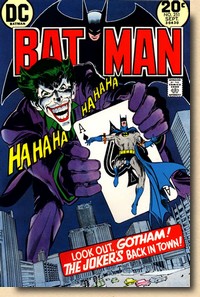
Batman #251 (Sept 1973),
contained in SuperPac C-8
|
|
| |
| Although highly systematic
at its core, the contents of a specific SuperPac could
always potentially deviate from the code of the pack they
came in in terms of cover date. This was hardly
surprising for titles which did not have a regular
monthly publication schedule or which were outright
bi-monthlies: Batman #251, with a September
cover date, was packaged in the C-8 SuperPac - which by
definition was actually one of four August SuperPacs. |
| |
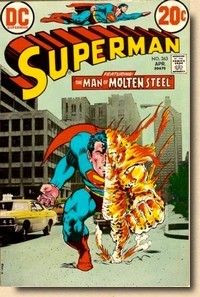
Superman #263 (April
1973), contained in SuperPac A-4
|
|
But then cover dates were a
tricky thing anyway, being around two to three
months ahead of the actual month of publication
in order to provide a longer shelf life at the
newsagents. However, things got
even more confusing at DC for the May 1973
production run:
"Cover
dates on comics didn't match magazine dating
norms, and by 1973 Marvel's cover dates made
them appear newer than DC's, so DC decided to
skip using May 1973 and go straight to
June." (Levitz, 2010)
As a result, there are no May
cover date issues of monthly titles. Not only did
Superman thus fall out of sync with the
SuperPac coding as of A-5, but this also meant
that there were only 11 issues of Superman
with a 1973 cover date.
|
|
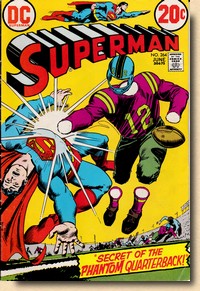
Superman #264 (June
1973), contained in SuperPac A-5
|
|
| |
| So when it came down to the
last SuperPacs of the year 1973, A-12 contained Superman
#271 - which strictly speaking had a January 1974 cover
date. This situation would continue until April 1975 when
DC, after a four month hiatus, relaunched its comicpacks
as "DC Super Stars". |
| |
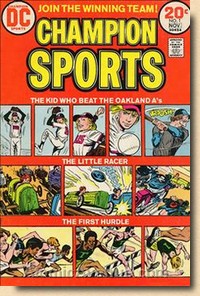
Champion Sports #1 (Sept
1973), contained in SuperPac C-9
|
|
DC's
1973 SuperPacs actually offered buyers two more
complete runs, although these were both new
bi-monthly titles only launched for September
1973; both their issues published that year were
to be found in SuperPacs: Champion Sports and
The Shadow. Champion Sports was
a short-lived attempt by DC to tap into the
sports genre, with stories written by Joe Simon
and illustrated by Jerry Grandenetti and Creig
Fleissel. The concept didn't latch on with
readers and the title was cancelled after only
three issues in March 1974.
The Shadow, on the
other hand, was DC's attempt at an authentic and
true to its origins interpretation of the classic
1930s pulp fiction novels and radio plays
vigilante. He also appeared that same year in Batman #253 (November
1973), in which Batman teams up with him and
calls the famous crime fighter his "greatest
inspiration".
|
|
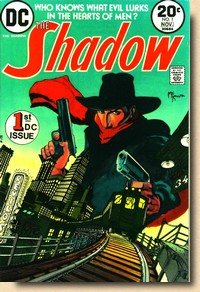
Shadow #1 (Sept 1973),
contained in SuperPac B-9
|
|
| |
| This was,
of course, not without a certain amount of irony as Bill
Finger, who today is widely regarded as the major
inspirational creative source for the Batman (Porter,
2008) together with artist Jerry Robinson, admitted at a
later point in time that his script for the very first
Batman story in 1939 "was a take-off of a Shadow
story" (Murray, 2007). |
| |
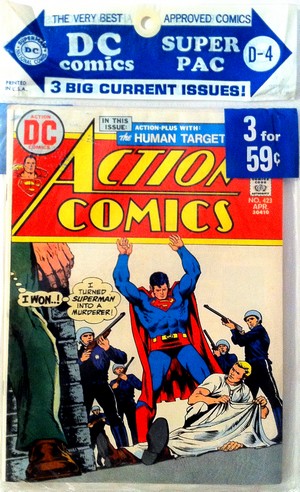
Super Pac D-4
with Action Comics #423 as one of its
showcased titles
Across:
World's Finest #220 (Dec 1973) from
SuperPac B-10 and Detective Comics #436
(Sept 1973) from SuperPac D-7
|
|
The
superhero titles also saw a near complete
run of the monthly Action Comics with
a total of 10 issues (only #422 and #429
weren't included), clearly making
Superman the top billed character. Taking into account
the Superman/Batman team-up title World's
Finest (which was packaged five
times throughout the year), the Man of
Steel appeared in an overall total of 27
issues, i.e. in almost every fifth comic
book contained in the 1973 Super Pacs.
Superboy (6
issues) and Supergirl (5) added to the
"Superman Family", with Jimmy
Olsen (7) and Lois Lane (5) completing
it. Anything linked to Krypton was very
much present in the contents of the 1973
Super Pacs.
However,
Batman was also well represented with 6
out of 8 1973 issues of his original
feature title, Detective Comics;
of the two missing issues one was a 100
pages Super Spectacular selling for 50¢
(and hence unsuitable for the Super Pac
format).
The genre
was completed by DC's other super power
regulars such as Flash (5) and Wonder
Woman (4), together with the newly
launched Captain Marvel. Once Superman's
rival in a copyright lawsuit before DC
acquired the rights to the character, the
"big red cheese" was pushed
quite a bit with 8 issues and would
almost certainly have seen a full 1973
cover date run if Shazam #8
hadn't been a 100 pages Super
Spectacular.
|
|
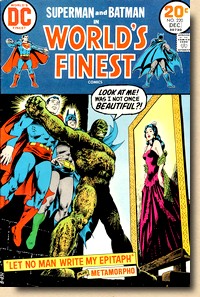
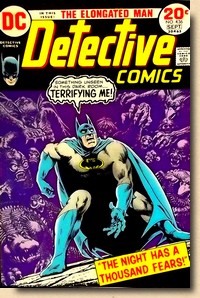
|
|
|
| |
| Green Lantern, who had lost
his own title in 1972, was now relegated to being the
backup feature in the bi-monthly Flash until January 1977
when his own solo title was revived. |
| |
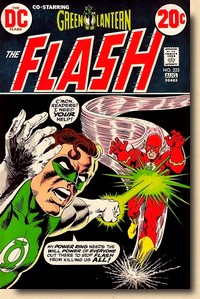
Flash #222 (Aug 1973)
from SuperPac D-6
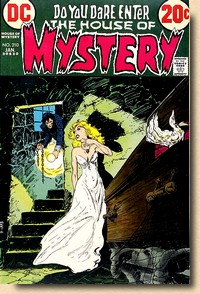
House Of Mystery #210
(Jan 1973) from SuperPac C-1
|
|
Superhero
team titles, on the other hand, were marginal;
the Justice League was featured five times,
whereas others had only one or two issues
packaged into Super Pacs over the entire year -
and three of them (Legion of Super-Heroes,
Teen Titans and Metal Men) were
even bound for cancellation. A few superhero
anthology titles also made it into a couple of
Super Pacs, such as Wanted (3 issues,
cancelled in 1973) or Secret Origins
(4). In terms
of superheroes, buyers (or happy recipients) of
any 1973 Super Pac thus stood a good chance of
finding a comic book featuring one of DC's iconic
characters inside, and arriving at a couple of
(even consecutive) issues was not at all
impossible.
With other genres,
you had to be lucky (or unlucky, if it didn't
appeal to you), and no less than 10 out of the 37
titles featured in the 1973 Super Pacs only made
a single issue appearance, while 7 titles only
notched up one more, i.e. two issues throughout
the year.
Trying to make out a
policy behind this is difficult and ultimately
speculative, but it must have also been driven by
the fact that only few DC titles actually had a
monthly publication schedule in 1973, so there
were gaps to fill - although House of Mystery
(which only saw issue #210 included in the 1973
Super Pacs) actually was one of the monthlies.
Concerns about family and kids friendly content
can hardly have played a role, as examples of the
(fairly tame) DC horror comics showed up much
more frequently in previous and subsequent years.
Other examples, such
as Johnny Thunder, didn't really leave
many other options - the reprint western title
was cancelled in mid-1973 after issue #3. This
was also the fate of some other titles which
appeared once only in a 1973 Super Pac: both
Metal Men and Legion of Superheroes
didn't make it through to the end of 1973.
|
|
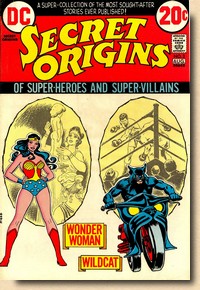
Secret Origins #3 (Aug
1973) from SuperPac A-6
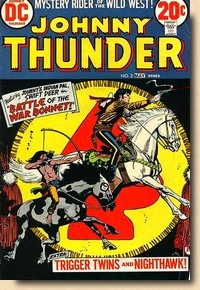
Johnny Thunder #2 (May
1973) from SuperPac C-4
|
|
| |
| It does however seem
slightly odd that out of the 8 titles carried in the 1973
Super Pacs which would end up being cancelled that same
year, the very last issue of no less than 4 of those
titles can actually be found in a SuperPac. |
| |
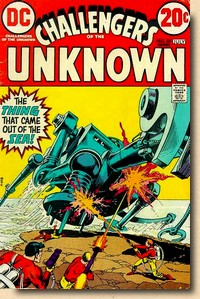 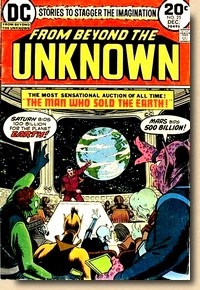  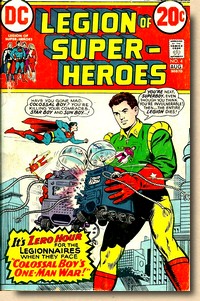 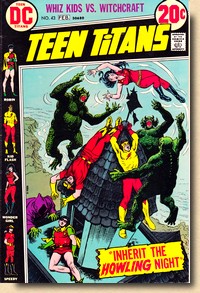
Last
issues before cancellation: Challengers of the
Unknown #80 (July 1973) from SuperPac C-5 / From Beyond
the Unknown #25 (Dec 1973) from SuperPac B-10 / Legion of
Super-Heroes #4 (Aug 1973) from SuperPac B-6 /Teen Titans
#43 (Feb 1973) from SuperPac A-1
|
| |
| |
THE 1973 DC
SUPER PACS SUMMARY
|
|
| |
| The 1973 Super Pacs from DC
can be summed up as follows: |
| |
- 48
comicpacks (four each month) containing three
comic books each
- 144
comic books - over one third of DC's total 1973
output (401 issues)
- 37
different titles
- 3 full
runs throughout the year (Superman, Batman,
Brave and the Bold)
- predominantely
packaged with superhero titles
- other
genres (apart from Sci-Fi and adventure titles)
clearly under-represented
- Superman
most prominent character
- some
oddities (e.g. sports titles)
- featured
two new titles and eight which were cancelled in
1973
- two
special themed Super Pacs, one horror and one
war, late in the year
|
| |
1973 DC
SUPER PACS IN FOCUS
|
|
| |
|
| |
| |



























